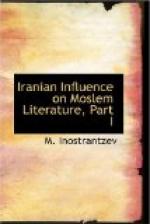[Footnote 1: For details, Goldziher. Muhammedanische Studien, I, 147-310.]
We noticed above the revival of scientific activities in Sasanian Persia. This activity for the most part has its significance in its quality of being a connecting link, in the first place, as the transmitter of Greek knowledge to the East, and secondly, as the unifier of this knowledge with the heritage which Sasanian Persia had received from scientific works belonging to Semitic culture, as well as from the science of India. The principal representatives of this activity were not Persians, but Christians, mainly the Syrian Nestorians, and Monophysites from the school of Edessa.[1]
[Footnote 1: For a general account of the character of this activity see T.J. de Boer, History of Philosophy in Islam, 17-20.]
What was the share in these operations of the Persians themselves it is hard to tell. But at all events, it was not considerable.[1] The general character of this activity does not leave particular room for wide creative science, since it has expressed itself pre-eminently in compilations, translations of philosophical, astronomical, astrological, medical, mathematical and ethical commentaries on Greek and some Indian authors. It was not in this field that the activity of the Persian sacerdotal community in the Sasanian epoch was concentrated. And latterly in the period of the development of analogous scientific work dining the eastern Khalifate under the Abbasides the principal role belonged just to the same class of scholars, Christian Syrians, with just this difference that the activity of the latter continued among the Musalman alumni of various nationalities whilst in Sasanian Persia their operations were cut short by the unfortunate circumstances of the Arab inroads. It is interesting that in the Abbaside period the translations made from the Persian authors or authors belonging to Persia appertain to a certain special genre of works of a technical nature, books on warfare[2], on divination, on horse-breaking[3], on the training of other animals, and on birds[4] trained to hunting. These special treatises were of no abstract scientific contents but referred to the practical demands of life.
[Footnote 1: As regards philosophical traditions of Sasanian Persia in the Musalman epoch principally we may refer to the influence of the system of “Zervanism” on the adherents of the system of “Dahar”, de Boer 15 and 76.]




